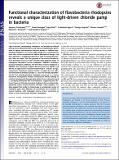| dc.contributor.author | Yoshizawa, Susumu | |
| dc.contributor.author | Kumagai, Yohei | |
| dc.contributor.author | Kim, Hana | |
| dc.contributor.author | Ogura, Yoshitoshi | |
| dc.contributor.author | Hayashi, Tetsuya | |
| dc.contributor.author | Iwasaki, Wataru | |
| dc.contributor.author | DeLong, Edward | |
| dc.contributor.author | Kogure, Kazuhiro | |
| dc.date.accessioned | 2014-12-01T21:43:54Z | |
| dc.date.available | 2014-12-01T21:43:54Z | |
| dc.date.issued | 2014-03 | |
| dc.date.submitted | 2014-02 | |
| dc.identifier.issn | 0027-8424 | |
| dc.identifier.issn | 1091-6490 | |
| dc.identifier.uri | http://hdl.handle.net/1721.1/91985 | |
| dc.description.abstract | Light-activated, ion-pumping rhodopsins are broadly distributed among many different bacteria and archaea inhabiting the photic zone of aquatic environments. Bacterial proton- or sodium-translocating rhodopsins can convert light energy into a chemiosmotic force that can be converted into cellular biochemical energy, and thus represent a widespread alternative form of photoheterotrophy. Here we report that the genome of the marine flavobacterium Nonlabens marinus S1-08T encodes three different types of rhodopsins: Nonlabens marinus rhodopsin 1 (NM-R1), Nonlabens marinus rhodopsin 2 (NM-R2), and Nonlabens marinus rhodopsin 3 (NM-R3). Our functional analysis demonstrated that NM-R1 and NM-R2 are light-driven outward-translocating H+ and Na+ pumps, respectively. Functional analyses further revealed that the light-activated NM-R3 rhodopsin pumps Cl− ions into the cell, representing the first chloride-pumping rhodopsin uncovered in a marine bacterium. Phylogenetic analysis revealed that NM-R3 belongs to a distinct phylogenetic lineage quite distant from archaeal inward Cl−-pumping rhodopsins like halorhodopsin, suggesting that different types of chloride-pumping rhodopsins have evolved independently within marine bacterial lineages. Taken together, our data suggest that similar to haloarchaea, a considerable variety of rhodopsin types with different ion specificities have evolved in marine bacteria, with individual marine strains containing as many as three functionally different rhodopsins. | en_US |
| dc.description.sponsorship | Japan Society for the Promotion of Science (Kakenhi Grant 24681003) | en_US |
| dc.description.sponsorship | Japan Society for the Promotion of Science (Kakenhi Grant 23710231) | en_US |
| dc.description.sponsorship | Canon Foundation | en_US |
| dc.description.sponsorship | Japan Society for the Promotion of Science (Strategic Young Researcher Overseas Visits Program for Accelerating Brain Circulation (Grant G2401)) | en_US |
| dc.description.sponsorship | Japan. Ministry of Education, Culture, Sports, Science and Technology (Grant-in-aid for Scientific Research on Innovative Area, "Genome Science," (22120518)) | en_US |
| dc.description.sponsorship | Japan. Science and Technology Agency | en_US |
| dc.description.sponsorship | Gordon and Betty Moore Foundation (GBMF 492.01) | en_US |
| dc.description.sponsorship | National Science Foundation (U.S.) (Grant EF0424599) | en_US |
| dc.language.iso | en_US | |
| dc.publisher | National Academy of Sciences (U.S.) | en_US |
| dc.relation.isversionof | http://dx.doi.org/10.1073/pnas.1403051111 | en_US |
| dc.rights | Article is made available in accordance with the publisher's policy and may be subject to US copyright law. Please refer to the publisher's site for terms of use. | en_US |
| dc.source | National Academy of Sciences (U.S.) | en_US |
| dc.title | Functional characterization of flavobacteria rhodopsins reveals a unique class of light-driven chloride pump in bacteria | en_US |
| dc.type | Article | en_US |
| dc.identifier.citation | Yoshizawa, S., Y. Kumagai, H. Kim, Y. Ogura, T. Hayashi, W. Iwasaki, E. F. DeLong, and K. Kogure. “Functional Characterization of Flavobacteria Rhodopsins Reveals a Unique Class of Light-Driven Chloride Pump in Bacteria.” Proceedings of the National Academy of Sciences 111, no. 18 (March 31, 2014): 6732–6737. | en_US |
| dc.contributor.department | Massachusetts Institute of Technology. Department of Biological Engineering | en_US |
| dc.contributor.department | Massachusetts Institute of Technology. Department of Civil and Environmental Engineering | en_US |
| dc.contributor.mitauthor | Yoshizawa, Susumu | en_US |
| dc.contributor.mitauthor | Kim, Hana | en_US |
| dc.contributor.mitauthor | DeLong, Edward | en_US |
| dc.relation.journal | Proceedings of the National Academy of Sciences | en_US |
| dc.eprint.version | Final published version | en_US |
| dc.type.uri | http://purl.org/eprint/type/JournalArticle | en_US |
| eprint.status | http://purl.org/eprint/status/PeerReviewed | en_US |
| dspace.orderedauthors | Yoshizawa, S.; Kumagai, Y.; Kim, H.; Ogura, Y.; Hayashi, T.; Iwasaki, W.; DeLong, E. F.; Kogure, K. | en_US |
| mit.license | PUBLISHER_POLICY | en_US |
| mit.metadata.status | Complete | |
